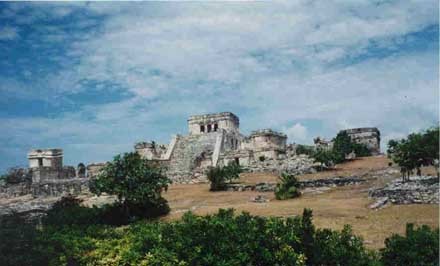
The vast majority of visitors to Cancun never make it south of Tulum. Yet to many, that’s where the adventure starts. The relatively empty region south of Tulum is a delight to nature lovers, ruin buffs and adventure travelers. The best way to see this region is to rent a car for several days but long distance busses are frequent on this highway.
If you start your trip in Chetumal, the southern city and capital of the state of Quintana Roo you should take some time to visit the Maya ruins near there.
The ruins close to Chetumal are some of the best on the Yucatan Peninsula. Kohunlich is in the forest and is extensive and delightful. Dzibanche is a newly restored “Tikal-like” city with almost no visitors yet has great restored temples on high pyramid bases. Both can be seen in a day from Chetumal. Other great sites further along Highway 186 are Xpuhil, Becan, Chicanna, Balku, the Rio Bec centers and of course, Calakmul, one of the major players in the Peten in the late Classic period. Basic and upscale lodgings are now available in the pueblo of Xpuhil.
I recommend renting a car for your trip up the coast but if not, then book a day tour in Chetumal to these places or it might even be cheaper to make a deal with a taxi driver to spend a day going to them. Before leaving Chetumal be sure and visit the Museum of the Maya Culture. I haven’t yet seen it but it is highly recommended in many books.
A nice place to see near Chetumal is Lake Bacalar (Laguna de los Siete Colores). The little town of Bacalar has a Spanish fort to check out and the lake itself is a fantastic place to swim and kayak. See if you can find a place to rent kayaks (or get a kayak tour) at the lake because it is an incredible place, especially at the south end where there are wetland channels and a small outlet called the Rio Chaak. The swimming in this fast current creek is great. There is plenty of jungle all around. The clear warm water is unreal! There are several upscale hotels located at the south end of Lake Bacalar.
An excellent side road to the coast goes from Cafetal, just beyond the north end of Lake Bacalar to Majahual, where hotels are springing up on the last long stretch of deserted beach on the east coast. From this location boats take divers and snorkel tours to the Chinchorro Banks, an enormous atoll and reef complex about 15 to 20 miles offshore. This “unspoiled” area is set to be the next huge area of coastal tourist development in the near future. It will undoubtedly change the character of the southeast coast from the tranquility of today to the supercharged pace of the Cancun area. See it before it is too late!!
Further up the highway toward Cancun is the sleepy town of Felipe Carillo Puerto. Don’t let the slow pace let you pass it by. It has the most incredible history of any town in Mexico. It used to be called Chan Santa Cruz and was founded by the rebel Maya following Yucatan’s Caste War (1847-1850), and until 1900 it was the capital of the only Native American state ever to become successfully established since the Spanish conquest of the Americas.
Chan Santa Cruz was built in part with the labor of Ladino slaves captured by the “Cruzob”, the rebels who worshiped a set of “speaking crosses” housed in the “Balam Na” or House of the Jaguar. The building, which was a Maya temple, is today the Catholic church of the town. This little town survived 50 years of Yucatecan and Mexican army raids before it finally surrendered 100 years ago.
While there, also go to see the Grotto of the Speaking Crosses, four blocks east of the central plaza. Virtually all of the Maya in this region are the descendants of the Cruzob rebels and there is no love for the Mexican government there.
The speaking crosses still exist and are housed in a small temple in the village of Tixcacal Guardia. Visitors are not allowed to view the “santisimas.” Maya villages housing the descendents of the Cruzob rebels are scattered in the dense forests around their former capital.
Just before reaching Tulum there is a small Cruzob village called Chunyaxche, where you can explore an interesting small Maya ruin, Muyil. The main pyramid, very similar to one at Coba is newly restored and is very photogenic. You can also enter a recently opened tomb in another rather ruined pyramid. When I entered the very dark burial chamber I was surprised (and delighted) to see the remains of recent offerings from the Maya villagers of Chunyaxche. The ancient Maya still live!!!
A wonderful thing to do there is ask the villagers to take you out into the nearby lakes (Laguna Chunyaxche and Laguna Muyil) inside of the Sian Ka an Biosphere Reserve. The lakes are fantastic and you can see “Petenes” or islands of old growth tropical forest rising out of the vast wetlands of the region. There is also an ancient Maya canal, dug more than 1000 years ago, straight as an arrow and several miles long which connects the ruin of Muyil with the sea. At the far end of Laguna Chunyaxche is a Maya temple, as if it were a guard station for trading canoes going into the lake. It is on the banks of a natural stream and the swimming there is fine. I wouldn’t miss this trip!!
You can make the arrangements to see this area by asking the villagers. Be sure and negotiate! Another possibility is to find a tour agency in Tulum and ask them to take you on a wetland boat tour of the lakes and the Xamach Lagoon of the Sian Ka an Reserve. Kayak tours are an even better way to really enjoy the quiet of the wetlands. Tours are the only legal way of seeing the reserve.
The once tiny Cruzob village of Tulum is now growing into city-status rapidly. However, it is well situated for forays to the many worthwhile places nearby. It is still a Maya town, although they may already be a minority. A motel or hotel room in Tulum is a good alternative to the pricy beach hotels on the nearby coast. The Tulum ruins are situated in a spectacular cliff and beach setting but are already the most visited archaeological site in the Americas. Go there before the multitudes of bus tours arrive in the morning or after they leave in the afternoon.
Be sure to visit Cobá ruins before going any farther north. It is the best ruin on that part of the coast although it is well inland. Cobá was a “Peten-style” Maya city having more in common with the Classic Maya cities of the lowland forests of Guatemala than the other Maya sites of the Yucatan. Two large pyramids tower above the tropical forest and dozens of small temples, pyramids and carved stelae dot this extensive site. Well marked paths through Coba are each atop an ancient road (sacbe). This is a fine place to get that “lost world” feeling and is a wonderful place to experience the tropical forest and to see forest life.
There are some small inexpensive hotels near the ruins (close to some beautiful lakes) and several restaurants. Bus service connects the site with Tulum and the cities of Chemáx and Valladolid to the north. If you drive there from Tulum there are several very nice cenotes (small freshwater sinkholes) with excellent swimming. Gran Cenote is located near the Tulum crossroad and is a nice one. Bring along snorkeling gear for cave swimming.
A noteworthy ruin north of Tulum is right across the highway from the entrance to Xelha National Park. The Xelha ruins are very nice and practically deserted considering the thousands of visitors to the National Park right next door! One temple, ten feet from the highway and easily seen as one cruises down the road, contains a painted wall mural of the Tlaloc war god of the great Central Mexican city of of Teotihuacán. Since that city was destroyed by fire around AD 600 the mural is very old in comparison to most of the other structures at Xelha. There are also wall murals to be seen a few miles south at Tancah ruin.
The national park at Xelha surrounds perhaps the most beautiful tropical lagoon in Mexico. The multihued waters, which extend like fingers into the surrounding forest teem with colorful fish and invite the visitor into the warm waters. Unfortunately, the volume of visitors to this fine place is overwhelming for its size and take away from the beauty of Xelha.
If you have some time while passing Puerto Morelos be sure to stop at two places. Crococun is a wild animal park (not real touristy) featuring local fauna like 16 foot long crocodiles. My favorite pen contains Maya “hairless” dogs. These quite ugly brutes were (and possibly still are) used as food by the Maya. Before the Spanish conquest, there were only a couple of domesticated animals in Mesoamerica: the dog and the turkey so reliable animal protein was limited.
The other place to see is the Botanical Gardens (Jardin Botanica). They contain the last stand of old growth tropical forest on the northeast coast and several interpretive trails have markers identifying the common trees and medicinal shrubs of Yucatan. More interesting to most are the many wild animals attracted to the park by virtue of the ban on hunting there. Monkeys swing from tree to tree and land mammals like deer, coatimundis and agoutis scamper around. It is a unique site! The last time I visited a guard showed me where a jaguar had jumped over a chain-link fence and eaten a deer the night before.
One is never far from the wilderness on the east coast. There are lots of beach towns between Tulum and Cancun, but they get quite touristy and crowded. Many expensive and moderately priced beach resort hotels line the beach for miles south of the ruins of Tulum. Cheap hotels can be found in Playa del Carmen and some smaller beach towns like Puerto Morelos.
You might also want to stay at Isla Mujeres, a laid back Mexican resort island just off the coast from Cancun. It can get crowded with day trippers from Cancun, though. The better choice for avoiding the crowds nowadays is Isla Holbox, on the northeast corner of the peninsula. Crossing the Yalahau lagoon in a small boat is quite refreshing and offers the opportunity to see pink flamingos and families of dolphins. The Holbox coast has one of the prettiest beaches in Mexico.

